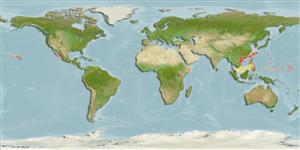>
Acanthuriformes (Surgeonfishes) >
Chaetodontidae (Butterflyfishes)
Etymology: Chaetodon: Greek, chaite = hair + Greek, odous = teeth (Ref. 45335).
Eponymy: Spencer Wilkie Tinker (1909–1999) was a malacologist who became the second Director of the Waikiki Aquarium, Honolulu (1940–1973). [...] (Ref. 128868), visit book page.
More on author: Schultz.
Environment: milieu / climate zone / depth range / distribution range
Ecologia
marinhas associadas(os) a recifes; intervalo de profundidade 27 - 180 m (Ref. 89972). Tropical; 28°N - 4°N
Pacific Ocean: formerly known to be endemic to the Hawaiian Islands. Recorded from Johnston Island (Ref. 11013) and the Marshall Islands (Ref. 5439). Replaced by Chaetodon declivis in the Line and Marquesan Islands (Ref. 37816).
Tamanho / Peso / Idade
Maturity: Lm ? range ? - ? cm
Max length : 15.0 cm TL macho/indeterminado; (Ref. 9710)
Espinhos dorsais (total) : 13 - 14; Raios dorsais moles (total) : 18 - 22; Espinhos anais: 3; Raios anais moles: 16 - 17. Differs from C. flavocoronatus by lacking a broad yellow band on the nape (Ref. 1602).
Often found in the vicinity of steep slopes, solitary or in pairs and occasionally in small aggregations (Ref. 4858). Benthopelagic (Ref. 58302). Feed on a variety of planktonic and benthic organisms (Ref. 4858). Oviparous (Ref. 205). Form pairs during breeding (Ref. 205). High-priced aquarium export (Ref. 37816).
Life cycle and mating behavior
Maturidade | Reprodução | Desova | Ovos | Fecundidade | Larvas
Form pairs during breeding (Ref. 205).
Myers, R.F., 1991. Micronesian reef fishes. Second Ed. Coral Graphics, Barrigada, Guam. 298 p. (Ref. 1602)
Categoria na Lista Vermelha da IUCN (Ref. 130435: Version 2024-2)
Ameaça para o homem
Harmless
Utilização humana
Pescarias: espécies comerciais; Aquário: Espécies comerciais
Ferramentas
Relatórios especiais
Descarregue XML
Fontes da internet
Estimates based on models
Preferred temperature (Ref.
123201): 20 - 27.4, mean 24.5 °C (based on 139 cells).
Phylogenetic diversity index (Ref.
82804): PD
50 = 0.5000 [Uniqueness, from 0.5 = low to 2.0 = high].
Bayesian length-weight: a=0.02291 (0.01133 - 0.04632), b=3.00 (2.83 - 3.17), in cm total length, based on LWR estimates for this Genus-body shape (Ref.
93245).
Nível Trófico (Ref.
69278): 3.4 ±0.48 se; based on food items.
Resiliência (Ref.
120179): Elevada, tempo mínimo de duplicação da população menor que 15 meses (Preliminary K or Fecundity.).
Fishing Vulnerability (Ref.
59153): Low vulnerability (10 of 100).
Nutrients (Ref.
124155): Calcium = 100 [51, 156] mg/100g; Iron = 0.843 [0.490, 1.442] mg/100g; Protein = 18.6 [17.4, 19.8] %; Omega3 = 0.145 [0.083, 0.248] g/100g; Selenium = 46.8 [24.6, 87.7] μg/100g; VitaminA = 48.2 [13.3, 177.4] μg/100g; Zinc = 1.4 [0.9, 2.0] mg/100g (wet weight);
